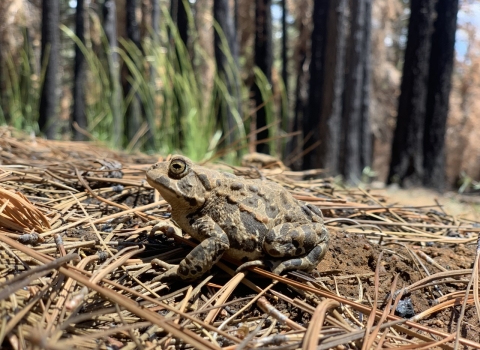Almost a year has passed since the Mosquito Fire roared through the American River Canyon just outside the small northern California community of Foresthill. Steep hillsides covered in oak and pine trees, shrubs and grasses went up in flames. The fire started on September 6, 2022, and burned for 46 days, destroying homes and small businesses and blackening more than 76,000 acres of National Forest and privately-owned lands. But a recent visit to the burn area provided some hope to wildlife biologists. A small population of California red-legged frogs, a threatened species, survived the fire.
“The Mosquito Fire went right through one of the most robust populations of the frog in the Sierra Nevada. It will take time for this area to recover, but the fact that this frog is still here shows the resiliency of wildlife,” said Rick Kuyper, division supervisor of the Sacramento Fish and Wildlife Office’s Sierra Cascades Division.
The California red-legged frog is found more often in California’s coastal areas, but it also calls the Big Gun Conservation Bank in Michigan Bluff, California, home. The conservation bank, managed by Westervelt Ecological Services, is a piece of conserved habitat for the frog, and surveys before the fire showed that it was home to one of the largest populations of red-legged frogs in the Sierra Nevada.
Based on the promising population data, biologists from the U.S. Fish and Wildlife Service and Tahoe National Forest agreed that steps could be taken to help the frogs expand onto nearby national forest lands. In 2021 and early 2022, the Tahoe National Forest built approximately 19 ponds within a mile of the conservation bank, giving the frogs new habitat to discover and populate.
But the Mosquito Fire put the conservation effort into question.
Michigan Bluff was heavily impacted by the Mosquito Fire; homes and businesses were lost, trees were burned to ash, and ponds at the conservation bank and Tahoe National Forest were turned into muddy puddles. Several months passed before the area was deemed safe for biologists to assess the impacts of the fire on listed plants and animals.
“When we got out to the ponds on the Tahoe National Forest, we could see that the area burned at a very high intensity. Almost every tree and shrub surrounding the ponds was killed, and most of the downed logs were completely consumed. We also saw that the water in the ponds was very cloudy due to the unstable soils left behind from the fire,” said Ian Vogel, senior wildlife biologist with the Service’s Sacramento Fish and Wildlife Office.
The team continued its assessment of the burn scar by visiting the Big Gun Conservation Bank. The land also burned, but less severely than the neighboring Tahoe National Forest. That gave biologists hope. They looked among the fallen trees, remaining water and burned shrubs for frogs. Then, a sharp-eyed biologist from Westervelt spotted a red-legged frog partially submerged in one of the bank’s remaining ponds.
Both Kuyper and Vogel viewed this discovery optimistically.
“Even though the area burned at high severity, the vegetation will eventually return. As the land and frog populations recover, we think it’s likely the frogs will expand to the ponds on the Tahoe National Forest,” said Vogel.
Although no California red-legged frogs were observed in the newly built ponds on Tahoe National Forest, large populations of the native tree frog were seen in many of the ponds. The fact that the tree frogs found the ponds quickly and are already using the ponds as breeding habitat shows the value of these ponds to native species. The group plans to return next spring and hope to see California red-legged frogs breeding at the conservation bank and in the Tahoe National Forest.
Wildfire continues to be a major threat to communities, wildlife and forest lands across the Sierra Nevada. The Service is working alongside the U.S. Forest Service and other partners to reduce wildfire risk while protecting habitat for listed species like the California red-legged frog, fisher and Sierra Nevada red fox. You can help reduce the risk of wildfire and keep our forests healthy by following the “Leave No Trace” principles when enjoying the outdoors.








